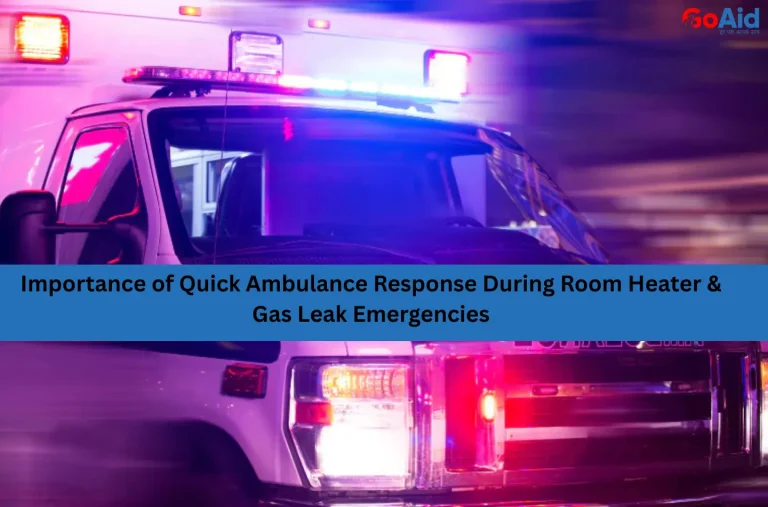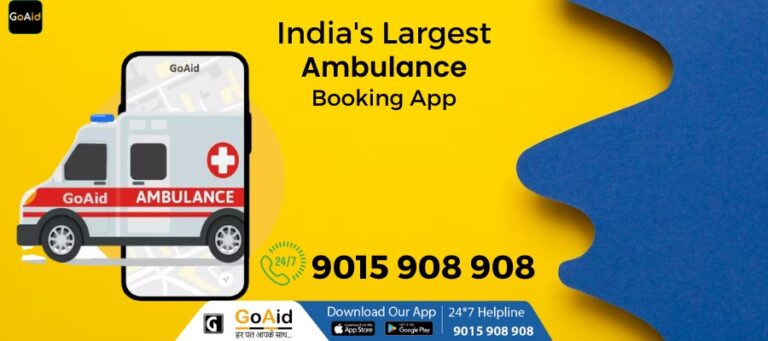In India, Mining is a high-risk industry where workers face a range of hazards, from minor injuries to medical emergencies. ThatŌĆÖs why having access to reliable ambulance services ensures rapid emergency care and minimizes delays in treatment. An ambulance for mining projects is essential for immediate emergency response.
In this blog, we have provided you with information about Common Health & Safety Problems in the Mining Industry, How can GoAid be used as a Reliable Partner for the Mining Industry ?, and the future of the Mining Industry. Are you interested in reading about it? If your answer is yes, why wait?
LetŌĆÖs start reading
Common Health & Safety Problems in the Mining Industry
The Mining Industry faces numerous hazards that require prompt ambulance support. Here are some common health and safety problems demonstrating why ambulance services are critical in mining:
- Manual Handling Injuries: Manual handling injuries, such as back strain or joint dislocation, are common in mining. They demand on-site ambulance service for quick assessment and transport to a hospital if needed to prevent complications.
- Heavy Machinery Accidents: Accidents involving heavy machinery cause serious trauma or fractures. Rapid emergency response and ambulance services are essential in mining projects to provide immediate medical care and minimize injury severity.
- Falls from Height: Falls from elevated mining sites often result in critical injuries. An ambulance for the mining industry safety is necessary to provide urgent first aid and fast transport to a hospital for advanced treatment.
- Exposure to Toxic Chemicals: Exposure to chemicals during mining operations can cause burns or poisoning. Ambulance services play a vital role in delivering quick emergency care to affected workers and preventing long-term health effects.
- Respiratory Issues: Dust inhalation and toxic gas exposure are common in mining, leading to breathing emergencies. Ambulance for mining industry services ensures timely respiratory support and emergency medical intervention.
- Electrocution Risks: Electrocution caused by faulty electrical equipment in mining requires immediate ambulance care. Quick emergency response can save lives and reduce the risk of severe injury.
- Vehicle Collisions: Collisions involving mining vehicles often cause severe injuries. On-site ambulance service provides essential emergency response and fast transport to healthcare facilities, improving survival chances.
Why Ambulance Services Are Essential for the Mining Industry
Ambulance for the mining industry safety is crucial due to the high-risk environment. Immediate emergency care reduces fatalities and complications, ensuring workers get timely treatment during medical emergencies at mining sites.
Rapid Emergency Response: Quick ambulance arrival minimizes critical delays in treating injuries, improving survival chances and recovery outcomes in the high-risk mining environment. A fast response is vital to save lives.
- On-site Medical Assistance: Ambulances staffed with trained paramedics provide immediate first aid and stabilize injured miners before hospital transport, ensuring better chances of recovery in mining emergencies.
- Handling Severe Injuries: Mining accidents often involve severe trauma and life-threatening injuries, requiring ambulances equipped with advanced life support to deliver critical medical care on-site.
- Reducing Fatalities: Timely ambulance intervention in mining projects helps reduce death rates by ensuring rapid emergency treatment and fast hospital transfers for injured workers.
- Compliance with Safety Regulations: Having ambulance services on-site meets legal safety requirements, protecting mining companies from penalties and improving workplace safety standards.
- Transportation to Specialized Care: Ambulances provide safe, fast transport to hospitals that specialize in mining-related injuries, ensuring injured workers receive expert medical attention promptly.
- Supporting Remote Locations: Ambulance services are essential for mining sites in remote or difficult-to-access areas, offering crucial emergency care despite challenging terrain or distance from hospitals.
Types of Ambulance Services Might be Required in the Mining Industry
Mining demands various ambulance types tailored to different emergencies. Each ambulance type addresses specific medical needs to provide comprehensive care at mining sites.
- Basic Life Support (BLS) Ambulance: Equipped to provide essential first aid and basic emergency care, BLS ambulances handle minor injuries and stabilize patients before hospital transfer at mining sites.
- Advanced Life Support (ALS) Ambulance: ALS ambulances include advanced medical equipment and trained paramedics to manage severe injuries and critical conditions common in mining accidents.
- ICU Ambulance: ICU ambulances are for critically injured miners needing continuous monitoring and intensive care during transport to specialized hospitals from mining locations.
- Oxygen Ambulance: Designed to supply oxygen therapy, oxygen ambulances address respiratory emergencies caused by dust inhalation, toxic gases, or other mining-related breathing problems.
- Mortuary Van: Mortuary vans transport deceased workers from mining sites to mortuaries respectfully, maintaining dignity and complying with legal requirements.
- Freezer Box Ambulance: Freezer box ambulances are specialized vehicles used to preserve bodies in extreme conditions before safe transfer from mining locations.
- Event Ambulance: Event ambulances provide medical standby support during mining events, large operations, or hazardous activities to ensure immediate emergency response if needed.
Know More: Difference between BLS Ambulance and ALS Ambulance
Current Challenges in Providing Ambulance Services to the Mining Industry
In India, providing ambulance services to mining industry sites faces several challenges due to remote locations, harsh environments, and high-risk injuries. These factors complicate timely emergency care and highlight the urgent need for specialized ambulance services in mining projects.
- Remote and Inaccessible Locations: Many mining sites are in isolated areas, making ambulance arrival and emergency response difficult, which delays critical care in medical emergencies in the mining industry.
- Harsh Terrain and Weather Conditions: Difficult terrain and extreme weather can hinder ambulance movement and timely emergency response for mining industry teams, impacting patient outcomes.
- Limited Communication Infrastructure: Poor network coverage at mining sites restricts quick ambulance booking and emergency coordination, slowing down response times for medical emergencies.
- High Risk of Severe Injuries: The mining industry injury ambulance services must be prepared for complex trauma cases, requiring advanced medical equipment and trained paramedics on-site.
- Insufficient On-site Medical Facilities: Many mining projects lack proper first aid stations, making ambulance services vital for immediate care and safe patient transfer.
- Regulatory Compliance Issues: Ensuring ambulance for mining industry safety meets government safety standards is challenging but necessary to avoid legal complications.
- Cost Constraints: High operational costs for ambulance services in remote mining areas can limit availability and affordability, affecting emergency medical care quality.
How Can These Problems Be Solved
In India, On-site ambulance services tailored for the mining industry’s needs are the best solution to overcome challenges. They provide fast emergency care, legal compliance, and effective medical response even in remote mining locations.
- Strategic Ambulance Placement: Deploying ambulances directly on or near mining sites ensures rapid emergency response mining industry teams can reach patients without delay.
- Specialized Ambulance Fleet: Using diverse ambulances equipped for mining industry injuries guarantees appropriate care for various emergencies, from minor injuries to critical trauma.
- Advanced Communication Systems: Equipping ambulances and mining sites with reliable communication tools enables faster ambulance booking and efficient emergency coordination.
- Trained Medical Staff: Ambulance teams trained specifically for mining emergencies provide expert first aid and emergency care, improving survival rates.
- Compliance with Safety Regulations: On-site ambulance services ensure mining projects meet government health and safety laws, avoiding penalties and improving workplace safety.
- Affordable Ambulance Options: Providing cost-effective ambulance service plans for mining industry helps overcome budget challenges while maintaining quality emergency care.
- Continuous Monitoring and Improvement: Regularly updating ambulance services and staff training enhances emergency preparedness and responsiveness in the mining industry.
Future of Emergency Medical Services in the Mining Industry
The future of emergency medical services in the mining industry is moving towards more advanced, technology-driven solutions to improve worker safety and emergency response times. Ambulance for mining industry projects will increasingly incorporate telemedicine, GPS tracking, and real-time health monitoring, allowing paramedics to deliver precise care even before reaching the site. These innovations aim to reduce fatalities and complications by providing faster and more effective emergency care on-site.
Additionally, the mining industry ambulance services will focus on expanding coverage to remote locations with specialized ambulance fleets equipped for various emergencies. The integration of AI-powered dispatch systems and drone-assisted medical deliveries will revolutionize emergency care in mining, ensuring that medical emergencies are managed swiftly and efficiently. This evolution will strengthen mining industry safety standards, ultimately safeguarding workersŌĆÖ lives and health in this high-risk sector.
Worker Welfare and Corporate Social Responsibility for the Mining Industry
Legal obligations and worker welfare demand that mining industries provide on-site ambulance services to ensure prompt emergency care. Corporate Social Responsibility (CSR) also plays a critical role in enhancing the mining industry safety and medical support for workers.
- Compliance with Government Regulations: Mining companies must provide ambulance for mining industry safety as mandated by Indian laws to ensure worker protection and legal adherence.
- Mandatory Emergency Preparedness: On-site ambulance services fulfill statutory requirements for emergency medical preparedness at mining sites, reducing workplace fatalities.
- Enhancing Worker Welfare: Providing ambulance services supports worker health and safety, demonstrating a commitment to employee well-being in the mining industry.
- Corporate Social Responsibility (CSR) Initiatives: Mining companies include ambulance services as part of CSR programs to promote community health and safety.
- Reducing Legal Liability: Proper ambulance facilities reduce the risk of lawsuits related to workplace accidents and medical negligence in mining projects.
- Building a Safety Culture: On-site ambulance availability fosters a safety-first culture, encouraging responsible mining practices and emergency readiness.
- Improving Public Image: Companies investing in ambulance for mining industry safety enhance their reputation as socially responsible and worker-friendly organizations.
How Can GoAid Be Used as a Reliable Partner for the Mining Industry?
GoAid provides tailored ambulance services for the mining industry, ensuring fast, reliable, and regulation-compliant emergency care. Its expertise, advanced fleet, and nationwide presence make it a trusted choice for mining projects and worker safety.
- Rapid Response System: GoAid ensures a 10-minute emergency response time, which is vital for mining industry safety, where delays can lead to severe health outcomes or fatalities in remote project locations.
- Diverse Ambulance Fleet: From Normal Ambulance to ICU and trauma-equipped ambulances, GoAid offers a wide range of vehicles suited to handle medical emergencies in mining industry sites effectively.
- On-Site Ambulance Availability: GoAid provides on-site ambulance services at mining locations, enabling immediate emergency care and transport, significantly reducing the response time during mining industry injuries or accidents.
- Trained Paramedic Teams: GoAidŌĆÖs ambulances come with experienced paramedics trained to handle mining-related emergencies, offering professional first aid and stabilizing patients before transferring them.
- 24/7 Emergency Coverage: GoAid operates a round-the-clock ambulance service for mining industry sites, ensuring emergency medical care is available at all hours, including nights, weekends, and holidays.
- Government-Approved Services: GoAid complies with all legal standards for ambulance operations, making it a trustworthy partner for mining industry projects requiring safety and legal alignment.
- Pan-India Service Network: With its wide national reach, GoAid offers ambulance support even in remote mining areas, maintaining continuity of emergency care across all mining industry zones.
Case Studies/Examples
Adani Group Mining Project:
Adani Group partnered with GoAid to enhance ambulance services across its mining operations in remote locations. GoAid provided a fleet of specialized ambulances equipped with advanced life support systems and trained paramedics. This partnership ensured rapid emergency response, reducing injury complications and improving worker safety. GoAidŌĆÖs 24/7 availability and government-approved services helped Adani comply with legal safety requirements while demonstrating a commitment to employee welfare and mining industry safety standards.
Tata Mining Operations:
Tata integrated the GoAid Ambulance Service into its mining safety protocols to address frequent medical emergencies on-site. GoAidŌĆÖs customized ambulance services, including oxygen and ICU ambulances, enabled Tata to manage severe injuries promptly. The collaboration improved emergency response times and ensured continuous medical support in challenging terrains. GoAidŌĆÖs use of advanced communication technology facilitated seamless coordination during emergencies, enhancing the overall mining industry’s injury ambulance readiness and contributing to TataŌĆÖs robust worker welfare initiatives.
Conclusion on the Need for Ambulance Services in the Mining Industry
Ambulance services are vital in the mining industry due to the high risk of injuries and medical emergencies inherent in mining operations. Having a reliable ambulance for the mining industry ensures rapid emergency response, expert on-site care, and timely transport to medical facilities. This not only saves lives but also minimizes the severity of injuries, enhancing overall worker safety and compliance with legal regulations. Mining industry ambulance services play a critical role in maintaining health standards and supporting emergency preparedness at mining projects.
Investing in specialized ambulance services tailored to the unique challenges of mining sites is essential for companies committed to worker welfare and operational safety. On-site ambulance availability ensures immediate medical attention, reduces fatalities, and builds a culture of safety. As mining projects expand, integrating advanced ambulance services will be key to protecting employees and fostering responsible mining industry practices.
Call-to-Action (CTA)
Ensure the safety of your mining workforce with GoAidŌĆÖs reliable ambulance services. Contact us today at 8008280020 or book via the GoAid app for fast, professional emergency care on-site.
FAQs on the Need for Ambulance Services in the Mining Industry
Question 1: Why are ambulances needed in the Mining Industry?
Answer: Ambulances provide rapid emergency care and safe transport for injured workers, reducing fatalities and improving medical outcomes in the high-risk mining industry environment.
Question 2: What types of injuries are common in the Mining Industry?
Answer: Common injuries include fractures, burns, respiratory issues, crush injuries, and trauma, requiring specialized ambulance services for the mining industry safety.
Question 3: Is it mandatory to have ambulance services in the Mining Industry in India?
Answer: Yes, legal regulations mandate on-site ambulance services in mining projects to ensure prompt emergency medical response and worker safety compliance.
Question 4: Can private companies provide ambulance services to the Mining Industry?
Answer: Yes, private ambulance providers like GoAid offer specialized services tailored for mining industry emergencies with trained paramedics and advanced medical equipment.
Question 5: What should the Mining Industry look for in an ambulance service provider?
Answer: Look for quick response times, trained paramedics, a diverse ambulance fleet, government approval, 24/7 availability, and experience in mining industry emergency care.
Question 6: What is an on-site ambulance service?
Answer: On-site ambulance service means having ambulances stationed within or near mining sites for immediate response to medical emergencies without delay.
Question 7: How does an ambulance service improve worker safety on Mining Industry?
Answer: Ambulance services provide timely medical care, reduce injury severity, ensure fast hospital transfers, and support compliance with safety regulations in mining projects.
Question 8: Are there any legal obligations for emergency medical support in the Mining Industry?
Answer: Yes, mining companies must comply with government rules requiring on-site ambulance services to protect worker health and reduce workplace risks.
Question-9: How much does it cost to hire an ambulance service for a Mining Industry?
Answer: Costs vary by service type and location, but affordable options with government-approved rates are available for mining industry ambulance services.
Question 10: Do ambulance providers offer trained paramedics along with the vehicle?
Answer: Yes, reputed ambulance services provide skilled paramedics trained in mining-related emergencies for effective on-site emergency care.
Question-11: Can ambulances be equipped with trauma kits for Mining-related injuries?
Answer: Absolutely, mining industry ambulances are equipped with advanced trauma kits to handle fractures, burns, respiratory distress, and other common injuries.
Question 12: How fast can an on-site ambulance respond compared to city emergency services?
Answer: On-site ambulances respond faster as they are stationed close to mining sites, ensuring emergency care within minutes.
Question 13: How does having an ambulance affect insurance and liability claims?
Answer: Ambulance availability improves worker safety compliance, reduces liabilities, and supports smoother insurance and compensation claims after mining accidents.
Question 14: Is a 24/7 ambulance service necessary for the Mining Industry?
Answer: Yes, mining operates round-the-clock, so 24/7 ambulance services are critical to handle emergencies anytime, day or night.
















